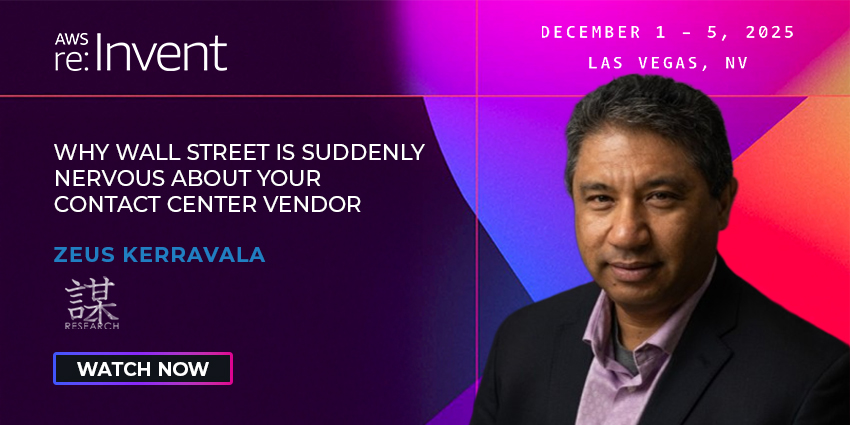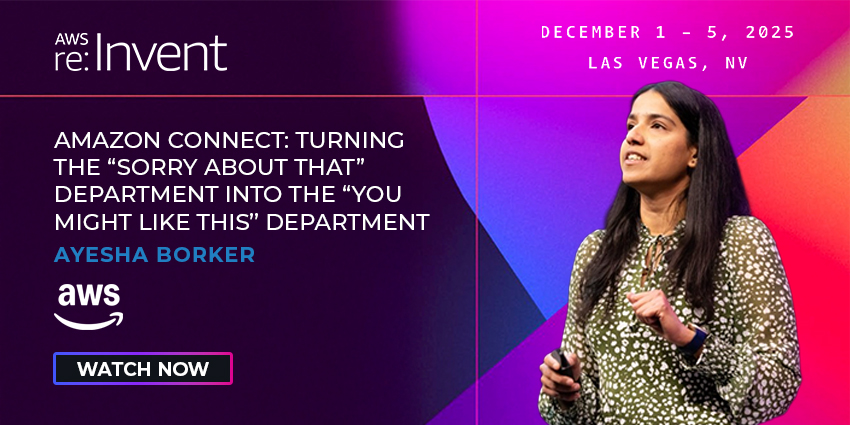Earlier this month, Amazon Web Services (AWS) held its inaugural Amazon Connect Horizons industry analyst conference.
Like most analyst events, AWS used the forum to share its vision of the industry and provide attendees with a roadmap of what’s to come for its contact center solution.
While I can’t go into product-level information, as much of it was under NDA, there were several key takeaways from the event worth sharing.
Below are my top four takeaways from Amazon Connect Horizons:
1. AI Agents Will Work in Harmony with Humans
Regardless of which event I attend, I inevitably hear about the rise of agentic agents with contact centers being viewed as the ‘low hanging fruit,’ as every organization is looking to improve the way it interacts with customers.
This always raises the questions of whether AI agents will replace humans, and the answer is yes and no, with it really depending on the type of interaction.
If one plots all the possible interactions between customers and a brand on a 2×2 grid with the axes being frequency and complexity, anything high-frequency and low-complexity is ideally suited for an AI agent.
This includes password resets, account balances, shipping status, and other mundane things people don’t like doing.
The rest of the more complex interactions will be handled by human agents, but these conversations will still have some element of AI in them. The conversation may start with an AI agent or AI could advise the human agent on what to say.
Over time, an AI agent will be a standard part of a contact center agent’s toolkit and will work with the human to provide upleveled interactions.
While I can’t get into the specifics of the information shared at the event, I can say this topic of bringing people and AI together was a big focus for Amazon Connect Horizons.
During my time there, I had a chance to talk to Pasquale DeMaio, VP of Amazon Connect, to get his thoughts.
DeMaio said:
“We believe a full agentic solution on top of Connect is the key to the future of everything we will do in customer service.”
“That doesn’t mean every interaction will be fully agentic. In fact, we believe that a human-centric experience is absolutely essential, and customers need the ability to seamlessly move back and forth across human and AI agents.”
2. Amazon Connect Is Not Just for Builders
The biggest misconception regarding Amazon Connect is that it’s only for builders.
That was true when the company launched Amazon Connect, but that was many years ago.
As DeMaio put it, Amazon “has always had more UX than API,” but the company does offer a best-in-class developer experience, as one would expect with it being an AWS product.
One of the ironies of this point is that because of the pre-built integrations Amazon Connect has, there is often less developer time required with some of its competitors.
One of the system integrators I talked with at the event told me that when going from Genesys on-prem to a cloud solution, the migration path to Amazon Connect is easier than with Genesys Cloud, because so much of it is integrated.
I asked DeMaio about developer-led customers versus out-of-the-box customers, and he explained that “the broad majority of our customers are not doing any or minimal development.”
He added, “I don’t want to dissuade customers from developing, but for almost everything we do, we have low-code and no-code interfaces making customization easy.”
This is consistent with the experiences of the customers I have talked to, as almost all of them have set up Amazon Connect with just a few mouse clicks.
3. Utilization Pricing Will Be the Norm in the Norm AI Era
One of the unique aspects of Amazon Connect is that it uses utilization-based pricing.
The majority of other CCaaS providers, by contrast, offer plans priced on a per-seat per-month basis, regardless of whether the seat is used or not.
Most customers will estimate the number of seats they need during peak periods, which creates a massive overpayment, as many of these seats will be unused most of the year.
Consider a retailer whose call volume skyrockets between Thanksgiving and Christmas. No retail organization wants its customers to have to wait too long in a queue, so they will staff up during these times.
With Amazon Connect, companies can provision as many seats as they want but only pay for the minutes used.
The criticism of this is that spend won’t be consistent month over month, which is true, but I have yet to talk to a customer that isn’t spending significantly less with utilization-based pricing.
Generally speaking, there are a handful of customers, such as government organizations, who prefer a consistent month over month cost, even if that means overspending, but that is no more than about 5% of companies.
With AI, vendors have been experimenting with different pricing models including per seat and outcome-based pricing, but the only one that will scale over time is utilization.
The concept of a “seat” doesn’t make sense with AI agents, as they are just machines, and a single agent can handle thousands of calls.
Since AI spins CPU/GPU cycles, it’s the easiest and fairest way to price and, over time, will become the norm.
4. A Fully Integrated CX Platform Will Create Differentiation in the AI Era
As an industry we talk about “CCaaS” as its own market but in reality, there is no such thing.
What customers really want is a CX solution that is comprised of CCaaS plus a bunch of other products such as quality management, WEF, WEM, and other functions.
Most of the traditional CCaaS providers have chosen partners for many of those functions, creating integration challenges and silos of data. With AI, silos of data lead to fragmented insights.
Looking ahead, vendors need to bring these capabilities together under a single platform to deliver AI that spans the entire customer journey.
AWS designed Amazon Connect to be a single platform to simplify deployments. In my conversation with DeMaio, he mentioned that when Amazon wins a customer, they often replace over 30 vendors, which greatly simplifies deployments.
In the AI era, a single platform is necessary to unify the data and provide meaningful CX insights.
Although Amazon Connect came to market prior to the AI boom, it was developed with this vision.
DeMaio has told me on several occasions that the mission of Amazon Connect is to create the most advanced CX AI solution that requires a single platform.
This is why the company chose to build its own adjacencies rather than trying to shortcut it with acquisitions. This will serve it well as AI capabilities become the criteria for vendor selection.
Summary
When Amazon Connect first came to market, I was skeptical as to whether a late entrant could create enough differentiation to usurp the established vendors.
AWS has certainly done that, as in just a few years it has gone from new vendor to Gartner MQ leader.
Connect initially targeted organizations looking to transform itheir customer experiences, but that’s all companies today.
Moving forward, AWS’ single platform, which encompasses CCaaS plus many of the adjacencies required to run a contact center, should serve it well as the AI transition moves from vision to reality.







